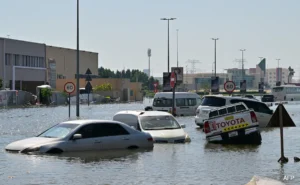It’s a futuristic fantasy that many have dreamed up, that humans could someday possess the power to control the weather. Artificial weather is an interesting, but ultimately fantastical pipe dream, or is it? Would you believe me if I told you that countries around the world have been artificially altering the weather for decades? Maybe you would, and maybe you’ve heard the term “cloud-seeding” going around in the media recently. You may have heard that it is an innovative, new solution to water scarcity and climate change. Or, maybe you heard that it is causing immense harm to the environment, including some extreme cases of flooding in the Middle East. But, what exactly is cloud-seeding, and why is it being done? Is this new innovative process a solution to environmental issues, or is it another cause?
To understand how cloud-seeding works, it is important to understand the science behind how clouds form. Clouds are formed when evaporated water cools and condenses around a small dust or salt particle in the atmosphere. A common misconception about cloud-seeding, is that these dust particles are being released into the atmosphere to facilitate the formation of clouds. That is close, but not completely accurate to what cloud seeding is. Cloud seeding is less concerned with cloud formation, and more concerned with increasing precipitation. There are multiple types of cloud seeding, but they all involve releasing particles (usually a type of salt) into already existing clouds to act as ice nuclei. These crystalline particles increase the rain-fall capacity of the cloud by causing ice crystals to form around the ice nuclei, thus increasing the ability of the cloud to induce precipitation. Cloud seeding has been used in the US and many other countries in the world for decades to fight drought, help agriculture, disperse fog, and even help out struggling ski resorts by increasing snowfall.
Cloud seeding has only been a widespread practice for a few decades, and the lack of research on the topic has led to the emergence of many environmental and ethical concerns. Because cloud-seeding has not been in practice for long, it is difficult to predict the long-term environmental effects on ecosystems. Cloud seeding often includes the release of materials such as silver-nitride, dry ice, and salt into the atmosphere, all of which, though being relatively harmless, have not been studied in their long-term ecological effects. There are also concerns about the meteorological effects of artificial rain, and what larger effects altering the climate could produce. More research is required to fully understand this, but there is evidence to suggest that altering weather patterns in one area could inadvertently affect the climate in a completely different region, or disturb climate patterns in general. There are also ethical concerns over this practice, as it brings up the question of who owns and controls natural resources. In regions where water scarcity is a pressing issue, concerns over who controls and owns water resources is a growing debate, and the concept of “creating” rain in one region amplifies these concerns.
Now, it is time to address one of the biggest accusations that cloud-seeding has received- that this technology has directly caused some disastrous flooding events. On April 16, 2024, a record amount of flooding caused by heavy rainfall hit the United Arab Emirates, heavily affecting the cities of Dubai and Sharjah. Cloud seeding is a common practice in this region and was immediately blamed as the cause of the flooding. However, after some investigation by experts into the flooding cause, it seems unlikely that cloud-seeding played a role. Dr Friederike Otto, senior lecturer in climate science at Imperial College London, stated that, “Even if cloud seeding did encourage clouds around Dubai to drop water, the atmosphere would have likely been carrying more water to form clouds in the first place, because of climate change” (BBC). Meteorologists at BBC also mentioned that heavy storms had already been forecasted by systems that do not take into account artificial rain fall caused by cloud seeding. So, this tremendous weather event was not in fact caused by cloud seeding, but is another long-term effect of human-caused global warming. Higher air and ocean water temperatures from global warming increases evaporation and cloud formation, subsequently leading to increased precipitation. Global warming seems to be a common thread connecting a plethora of increased occurrences of natural disasters that we have seen in the last decade.
In conclusion, the concept of artificial weather, once confined to the realm of science fiction, has become a reality in many parts of the world through cloud-seeding. While initially seen as a solution to water scarcity, the widespread use of cloud-seeding raises significant environmental and ethical concerns. The lack of long-term research on its ecological impacts, coupled with the potential for unintended meteorological consequences underscore the complexity of manipulating weather patterns. Moreover, recent events such as the flooding in Middle East highlight the need for a deeper understanding of the interactions between human behavior and natural processes in the context of climate change. While cloud seeding may not be directly causing these floods, as many people were quick to believe, it is clear that we as a society have much to learn about the long-term effects our actions have on the environment we are so eager to alter. As we navigate the relationship between innovation and responsibility, it becomes increasingly clear that the quest to control the weather requires careful consideration of its broader implications for our planet.
Sources
Anderson, B. (2024, April 23). What is cloud seeding (or Artificial Rain)?. Greenly. https://greenly.earth/en-us/blog/ecology-news/what-is-cloud-seeding-or-artificial-rain
CBS Interactive. (n.d.). What is cloud seeding and did it play any role in the Dubai floods?. CBS News. https://www.cbsnews.com/news/what-is-cloud-seeding-and-did-it-impact-dubai-floods/
How climate change is making record-breaking floods the new normal. UNEP. (n.d.). https://www.unep.org/news-and-stories/story/how-climate-change-making-record-breaking-floods-new-normal
Silva, M. P. & M. (2024, April 17). What is cloud seeding and did it cause Dubai flooding?. BBC News. https://www.bbc.com/news/science-environment-68839043
What is cloud seeding?. DRI. (2022, September 19). https://www.dri.edu/cloud-seeding-program/what-is-cloud-seeding/#:~:text=Cloud%20seeding%20is%20a%20weather,base%20for%20snowflakes%20to%20form.




